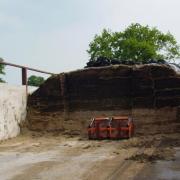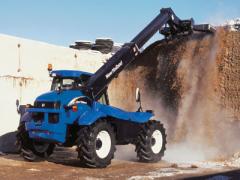
(Source: Penn State Ag Safety and Health)
Use the following format to cite this article:
Horizontal silo safety. (2013). Farm and Ranch eXtension in Safety and Health (FReSH) Community of Practice. Retrieved from http://www.extension.org/pages/68328/horizontal-silo-safety.
The term horizontal silo refers to a storage system in which silage is piled in low, long piles in a space that may or may not have sidewalls. Horizontal silos vary in size depending on the scale of the farm operation. There are several common types of horizontal silos:
- A bunker silo (shown above) is a horizontal silo with construction-grade materials for sides.
- A trench silo is cut into the earth.
- Drive-over piles are piles of silage that are dumped on the ground or a hard surface without walls.
Silo Inspection
All types of horizontal silos can have damage from wear and tear, so it is important to inspect bunker silos for cracks in the sidewalls before harvesting silage. Sidewall cracks should be repaired immediately to maintain the integrity of the wall. Sidewalls in a trench silo can slip and the floors in trench silos and drive-over piles can become muddy or rutted.
Sighting rails (shown below) made of iron or steel pipe should be installed and maintained on bunker silos to provide visual clues for the operator as he or she backs up and unloads and packs forages. Note that these railings will not prevent a tractor or truck from overturning, but they can serve as fall protection for workers placing plastic and weights on the packed silage.

Packing Safety
Silage should be packed tightly, and packing of silage should be completed quickly. Packing in this manner helps to exclude oxygen from the silage, which in turn promotes effective fermentation. In the rush to complete the packing process, especially when multiple trucks and tractors are used, the prevention of rollover incidents is a primary safety concern. To reduce the risk of a rollover incident, packers should use a safe slope or progression wedge (shown below) with a maximum slope of 3:1 (3 ft. of horizontal run to 1 ft. of vertical drop). The slope should be maintained on all sides of drive-over piles. Tractors used for packing silage should be equipped with rollover protective structures (ROPS), and operators should always wear seat belts.

(Source: Pennsylvania State University, Agricultural Safety and Health)
Some farm operations utilize dump trucks to haul forage to the silo. Like tractors, dump trucks can also overturn, so operators should always wear their seat belts and should keep the truck’s center of gravity between the frame rails of the truck. When the dump bed is raised, the truck becomes less stable, especially on uneven or sloped terrains. The following hazards can cause dump trucks to roll over:
- Tire ruts
- Depressions
- Wind gusts
- Uneven loads
- Low tire pressure on one side of the truck
Operating dump trucks and packing equipment away from the sidewall will help prevent damage to the sidewalls of a horizontal silo and will help reduce the risk of overturn incidents.
Once the packing process is completed, the silage should be covered with plastic and weights, requiring workers to stand or walk on the sidewalls of a bunker silo. Fall protection is necessary to reduce injury risk to workers completing this task. Fall-protection standards require that anytime workers are on a walking or working surface with unprotected sides that are 6 ft. or more above a lower level, the workers should be protected through the use of guardrails or other fall-protection systems. Sighting rails on the sides of a bunker silo can be considered guardrails if their construction meets standard handrail specifications. Click here for the specific fall-protection standard outlined by the U.S. Department of Labor, Occupational Safety and Health Administration (OSHA).
Safety Precautions during Feedout
There are several potential causes of injury during the feedout process, including the following:
- Equipment rollover
- Entanglement
- Silage collapse due to undercutting
Undercutting occurs when silage-loading machines (for example, tractor front-end loaders, skid steers, and so on) are not able to reach the top of the silage face. Silage in horizontal silos can be packed to heights of 20 to 40 ft., and most pieces of equipment on traditional farm operations are too small to reach the top of the silage. If a machine is not able to reach the top of the silage and instead continually removes silage from the bottom, the process creates an overhang (shown below) that could potentially collapse and bury workers, bystanders, and equipment beneath tons of silage.

(Source: Keith Bolsen, Kansas State University)
One way to reduce undercutting is through the use of a silage defacer. A silage defacer has a hydraulic set of rotating knives mounted in an open framework. The defacer is mounted to a skid steer or material handler’s boom (shown below). The purpose of the defacer is to loosen silage vertically from the top to the bottom of the silage face in the horizontal silo, eliminating the undercutting that causes an overhang hazard.

(Source:New Holland North America)
Operators using a silage defacer must read the operator’s manual prior to using the equipment to understand how to operate the equipment safely. Anyone operating the silage defacer should first clear the work area of all bystanders. The defacer should be operated only from the operator’s station. The defacer should be positioned at the top of the silage feedout area before the motor is engaged. Once the motor has reached full speed, the unit should be slowly lowered to cut through the recommended depth (that is, 1 to 3 in. per pass). As with all equipment, the operator should not leave the operator’s station until the unit has been shut down, parts have stopped moving, and the keys have been removed from the ignition switch.
It is recommended that no one stand at a silage face that exceeds his or her height. Silage faces can collapse even if an overhang hazard is not present (for example, when a frozen chunk of silage breaks loose). This type of hazard is especially dangerous for individuals, such as nutritionists or students, collecting silage samples. To reduce the risk of a silage-face collapse, those collecting samples should use a loader to scoop up silage and move it away from the silage face before gathering samples from the loader bucket.
Regulations Regarding Hired Labor
Any agricultural operation employing 11 or more workers should adhere to the following standards under OSHA:
- Rollover Protective Structures (ROPS) for Tractors Used in Agricultural Operations (1928.51): The ROPS standard requires that employees use only tractors equipped with a ROPS and seatbelt.
- Guarding of Farm Field Equipment, Farmstead Equipment, and Cotton Gins (1928.57): This standard requires that power take-off (PTO) shafts and other moving parts of machinery and equipment be equipped with proper guarding.
The U.S. Department of Labor governs regulations regarding youth employed in agricultural operations. Youth aged 14 and 15 can be employed on farms and ranches, but they must complete a course and receive a certificate of training under the regulations of the Agricultural Hazardous Occupations Order (AgHOs) before operating tractors or powered farm equipment. AgHOs regulations do not apply to youth age 16 or older or to youth working on their own family farms. Safety training is important for all agricultural workers, but it is especially important for youth working on any farm.
Producers who hire custom operators should ensure that the operators are familiar with the farm or ranch’s fields, roads, lanes, and silage storage facilities. It is the responsibility of the farm owner or producer to provide a safe workplace for contractors and warn them of any hazards that cannot be eliminated. All custom operators that have employees should have proof of workers’ compensation and insurance coverage and should provide their workers with safety training.
Additional Safety Recommendations
Producers and workers should adhere to the following safety recommendations when working around horizontal silos:
- Allow only mature, experienced individuals to operate equipment.
- Use tractors that have a low clearance and wide front end.
- Use tractor weights to improve stability.
- When packing on sloped surfaces, move by backing the tractor up the slope.
- When packing, use a tractor equipped with front-wheel drive or front-wheel-assist drive for additional traction and stability.
- When using a dump truck on the forage slope, back the truck up the slope to reduce the risk of a side overturn.
- Do not fill a bunker or trench silo higher than the sidewalls.
- Know where workers are located and use standard agricultural hand signals to communicate.
Use the following format to cite this article:
Horizontal silo safety. (2013). Farm and Ranch eXtension in Safety and Health (FReSH) Community of Practice. Retrieved from http://www.extension.org/pages/68328/horizontal-silo-safety.
Sources
Harshman, W., Yoder, A., Hilton, J., and Murphy D. (2013) HOSTA Task Sheet 3.9.2: Packing forage in a horizontal silo. The Pennsylvania State University. Hazardous Occupations Safety Training in Agriculture. Retrieved from http://www.extension.org/sites/default/files/NSTMOP%20Task%20Sheets%20Se….
Harshman, W., Yoder, A., Hilton, J., and Murphy D. (2013) HOSTA Task Sheet 6.9: Silage defacers. Retrieved from http://www.extension.org/sites/default/files/NSTMOP%20Task%20Sheets%20Se….
Murphy, D. and Harshman, W. (2007) Horizontal silo safety. The Pennsylvania State University College of Agricultural Sciences. Retrieved from https://extension.psu.edu/horizontal-silo-safety.
Reviewed and Summarized by:
